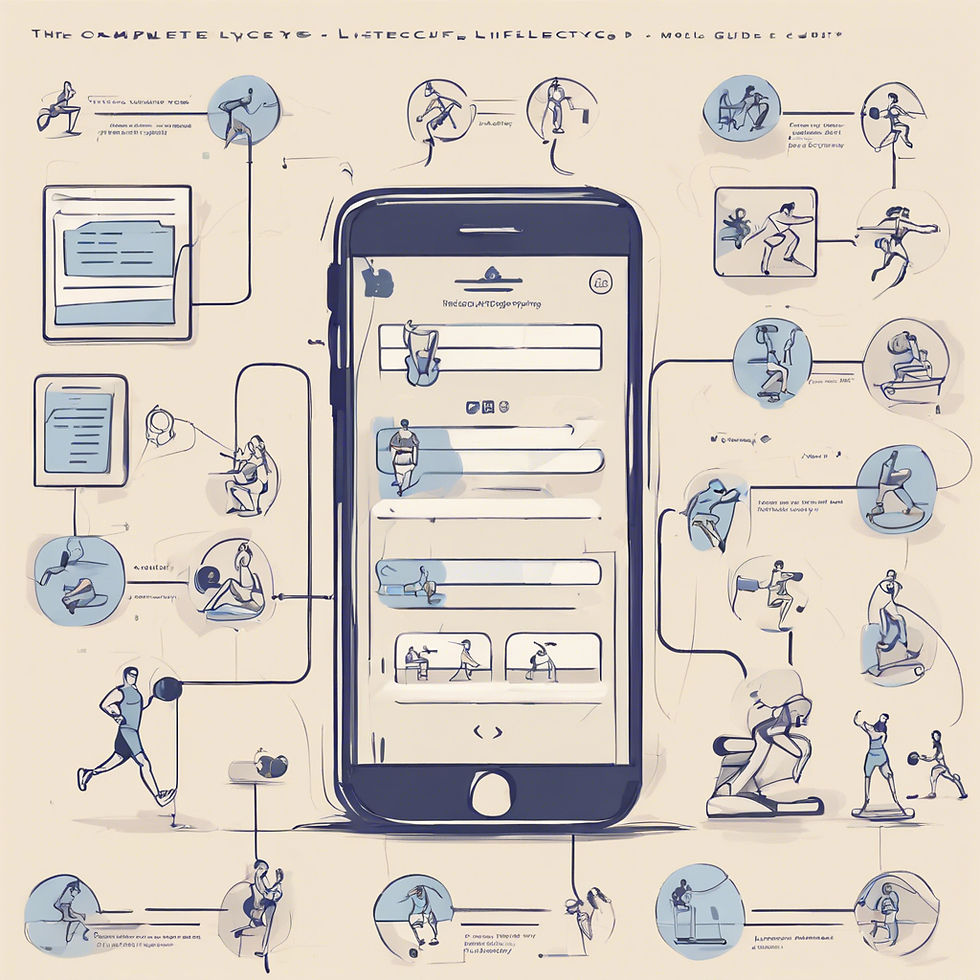The Complete Product Lifecycle Guide: Building a Successful B2C Mobile Application (with an example of a Fitness application)
- Gunasindhu

- Jan 28
- 4 min read

In today's digital fitness revolution, creating a successful B2C fitness application requires more than just good intentions and basic workout tracking. This comprehensive guide explores the complete product lifecycle of a fitness app, from conception to maturity, highlighting crucial considerations at each stage.
1. Discovery and Market Research Phase
Understanding the Fitness App Landscape
The fitness app market has evolved significantly, moving beyond simple step counting to comprehensive health and wellness platforms. Before diving into development, it's crucial to understand where your app fits in this ecosystem.
Current market trends show users seeking:
- Personalized workout experiences
- Integration with wearable devices
- AI-powered coaching and feedback
User Research and Persona Development
Successful fitness apps are built on deep user understanding. Our research identified several key user personas:
- The Busy Professional: Seeks quick, effective workouts that fit into a tight schedule
- The Beginner: Needs guidance and motivation to start their fitness journey
- The Goal-Oriented User: Focuses on specific targets (weight loss, muscle gain, etc.)
2. Design and Planning Phase
UX/UI Considerations
Fitness apps present unique UX challenges due to their use during physical activity.
Guidelines to be followed :https://gunaslab.wixsite.com/product-pitch/post/screen-size-and-usability-for-mobile-product
Key design principles include:
Workout Mode Interface
The interface must be easily readable and interactive while users are in motion. This means:
- Large, clear typography
- High contrast color schemes
- Simple, sweat-proof touch interactions
- Voice control options for hands-free operation
Data Visualization
Users need to understand their progress at a glance:
- Clear progress charts and graphs
- Visual representation of workout completion
- Achievement badges and milestones
Technical Architecture Planning
Modern fitness apps require robust backend systems to handle:
- Real-time workout tracking
- Data synchronization across devices
- Video streaming for workout content
- Machine learning for form correction
- Social features and user interactions
3. Development and Testing Phase
Core Feature Development
Priority features typically include:
-Workout Tracking
- Custom workout creation
- Exercise library with video demonstrations
- Progress tracking and history
Social and Engagement
- Friend connections and following
- Community challenges and leaderboards
- Achievement sharing
- In-app messaging and support
Health Metrics
- Weight and body composition tracking
- Heart rate monitoring
- Sleep analysis
- Nutrition logging
Integration Considerations
Modern fitness apps must play well with others:
- Apple HealthKit and Google Fit integration
- Popular wearable device compatibility
- Calendar app synchronization
- Social media sharing capabilities
4. Launch Strategy and Growth Phase
Pre-Launch Activities
Building anticipation and ensuring a smooth launch:
- Beta testing program with fitness enthusiasts
- Influencer partnerships and early access
- Content creation for initial workout library
- Customer support team training
- App store optimization (ASO) strategy
Marketing and User Acquisition
Effective channels for fitness app promotion:
- Social media marketing (Instagram, TikTok, YouTube)
- Fitness influencer collaborations
- Paid advertising on health-related platforms
- Content marketing (blog posts, workout videos)
- Email marketing campaigns
5. Optimization and Iteration Phase
Data-Driven Improvements
Key metrics to track and optimize:
User Engagement Metrics
- Daily Active Users (DAU)
- Workout completion rates
- Session duration
- Feature usage patterns
- Social interaction levels
Business Metrics
- User acquisition cost
- Retention rates
- Subscription conversion rate
- Revenue per user
- Churn prediction
Continuous Improvement
Areas for ongoing optimization:
Performance Optimization
- App load times
- Video streaming quality
- Battery consumption
- Data usage efficiency
- Offline functionality
User Experience Enhancement
- Personalization algorithms
- Workout recommendations
- Form correction accuracy
- Progress tracking insights
- Social feature engagement
6. Maturity and Evolution Phase
Platform Expansion
As the app matures, consider:
- Corporate wellness programs
- Integration with fitness centers
- Personal trainer marketplace
- Equipment partnerships
- International expansion
Feature Evolution
Advanced features to consider:
- Live streaming classes
- Virtual reality workouts
- Advanced biometric tracking
- Personalized nutrition planning
- Mental wellness integration
7. Risk Management and Compliance
Privacy and Security
Critical considerations:
- GDPR and CCPA compliance
- Health data protection
- Secure payment processing
- User consent management
- Data encryption standards
Legal Considerations
Important aspects to address:
- Liability waivers
- Terms of service
- Health disclaimers
- Intellectual property protection
- Age restrictions
Conclusion
Building a successful B2C fitness application requires careful attention to each phase of the product lifecycle. The key to success lies in understanding user needs, maintaining technical excellence, and continuously evolving the platform based on user feedback and market trends.
Remember that the fitness app market is highly competitive and constantly evolving. Success depends not just on following this lifecycle guide, but on maintaining agility and responding quickly to changing user needs and technological advances.
The most successful fitness apps are those that create lasting value for users while building a sustainable business model. Focus on creating genuine impact in users' lives through effective features, engaging content, and a supportive community.

Comments